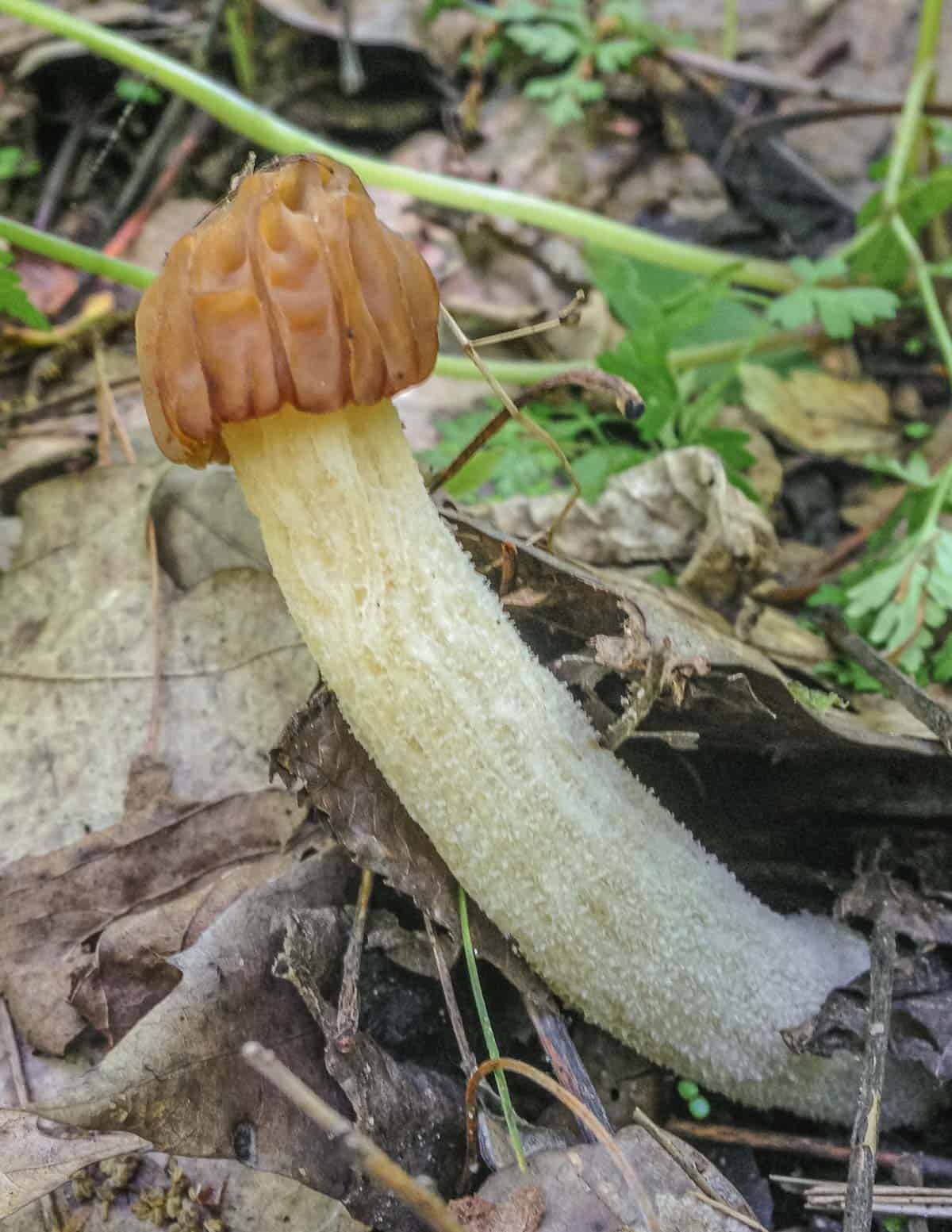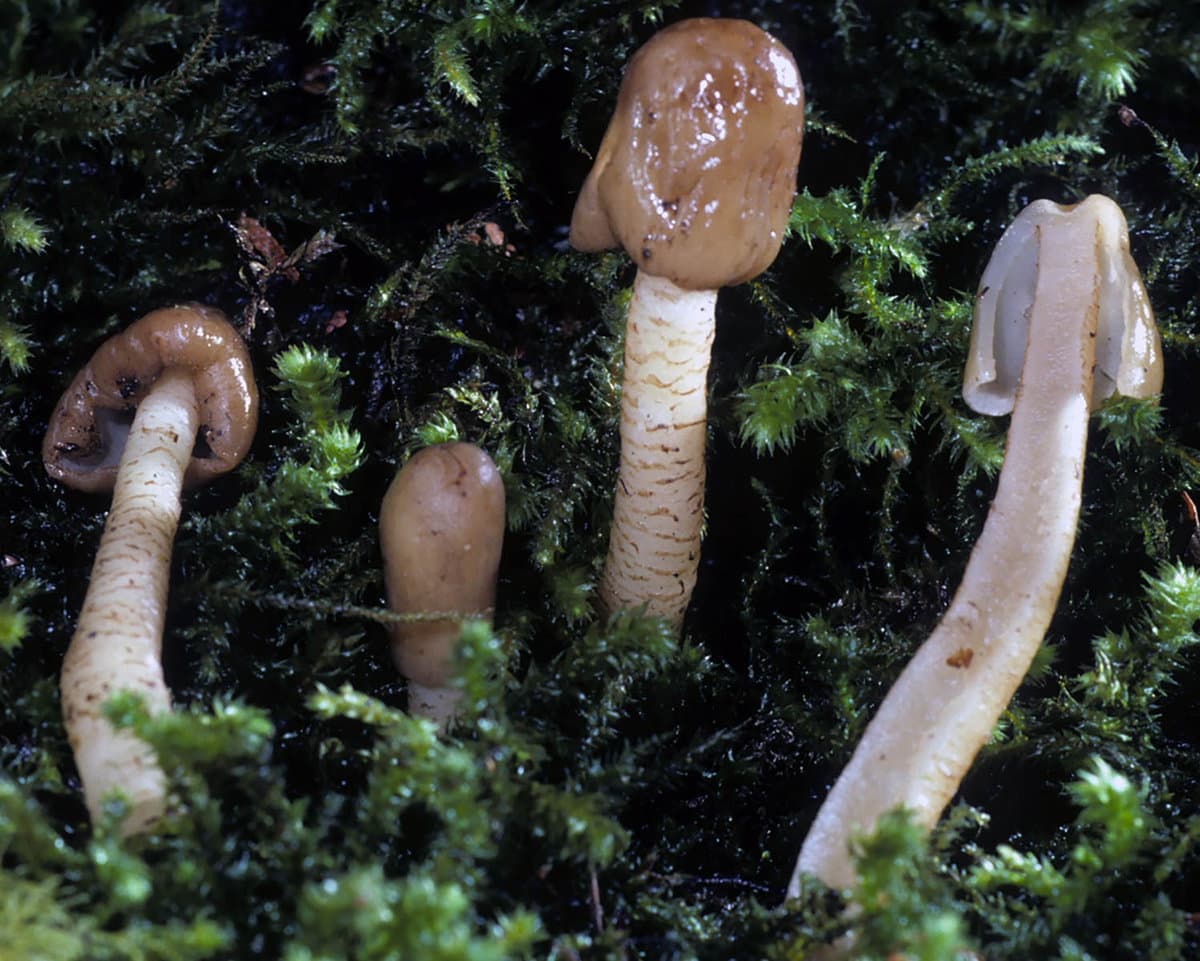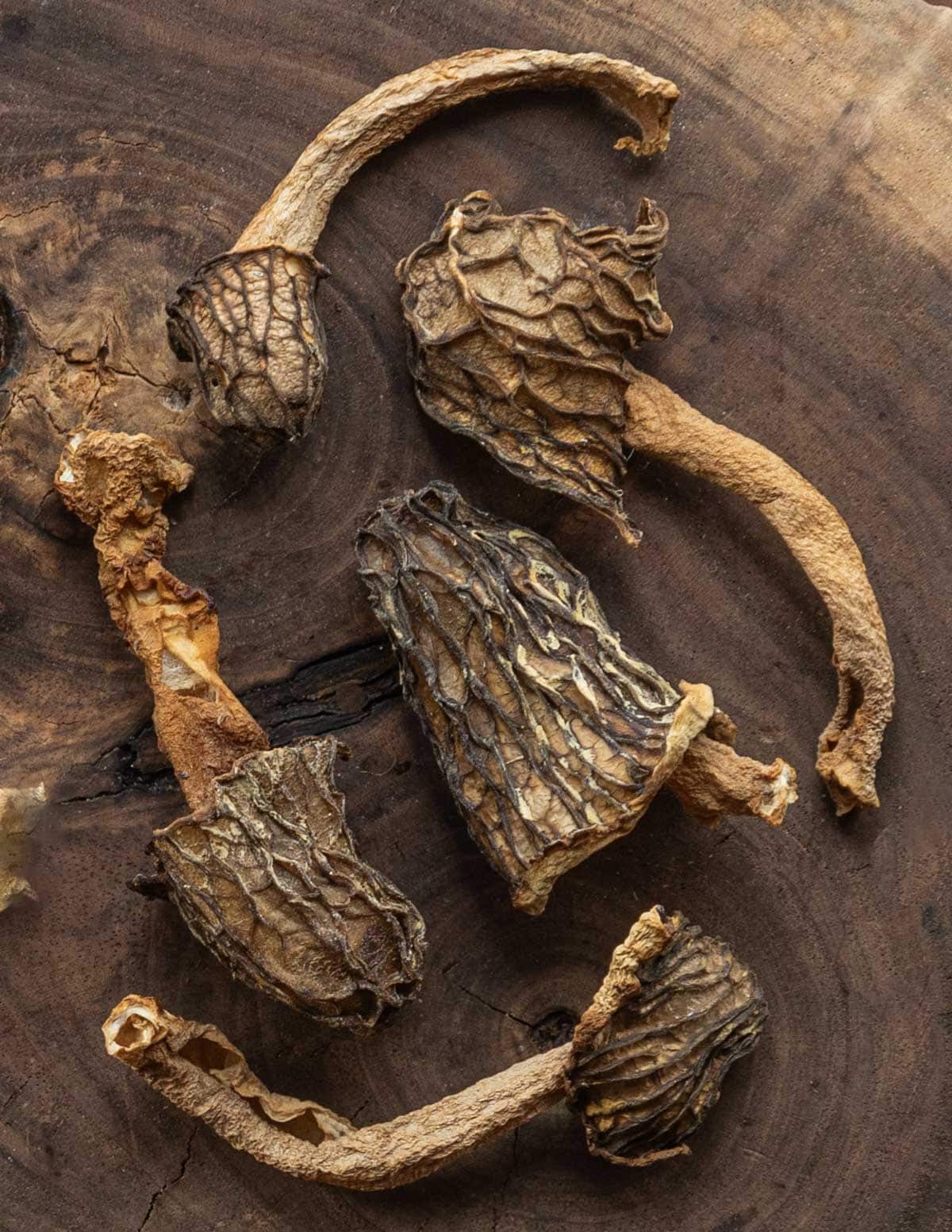Verpa bohemica is one of many mushrooms that appear in the Spring before morels. Long enjoyed as an edible mushroom in Europe, they have a complicated reputation in North America. Verpas are edible just like morels, but, just like morels, there's some important things to understand about them. Today we'll look at their background, how to identify and cook them.

Special Thanks
This post wouldn't be possible without my friends at False Morels Demystified. They do a great job distilling complex information for mushroom hunters of all skill levels. Seeing posts from lifelong skeptics who've just cooked their first Gyromitra will warm your mushroom hunting heart.
Background
Also known as thimble morels, Verpas are a mushroom in the Morchellaceae family, just like morels. Unlike morels, they're in the genus Verpa where morels are in the genus Morchella. To be a true morel, a mushroom must be in the Morchella genus, confusingly, they were originally known as Morchella bohemica.
Bohemica comes from the word Bohemia in a nod to where the mushrooms were first described (Czech Republic). Tradition with these mushrooms runs deep in Europe, as you can see from the picture-perfect basket below a Czech mushroom hunter was nice enough to let me share.

In France they're a champignon de printemp-one of many spring mushrooms gathered for the table. They're also known as Verpe de Bohême or morillones (morels in French is Morilles). European mycologists may use the older name Ptycoverpa bohemica. Morchella bispora is another synonym.
A great reference on the tradition of cooking of verpas and other early morels everyone should read is the article in Fungi Magazine. It discusses their consumption in Emilia Romagna where the common name for them is "little friars".

France and Italy are only the best documented examples of traditional food use I can find. Another thing to consider is that, as the mushrooms are easily confused with morels and often mixed in with them on accident, their consumption (in small amounts) is undoubtedly underreported in North America.

Verpas are known to find their way into farmers markets mixed with true morels, and are counted as morels in some spring mushroom hunting competitions. In 2020 I noticed V. bohemica being offered to chefs in the United States, as you can see below.

Verpa Season
Appearing dependably 1-2 weeks earlier than morels (late April-early May in the Midwest), Verpas like the same mixed hardwood habitat as many morels but can also grow with conifers.
Seeing them is a good indicator that you're in the right terrain, and you should return in a week or two for the real thing. While they're widespread across North America, they're more prevalent in the northern regions.

Like morels, the way they interact with trees hasn't been proven definitively and could be a combination of both mycorrhizal (symbiotic) and saprobic (decomposing) growth.
Identification: Verpa bohemica vs Morels
V. bohemica is often confused with morels and half-free morels (M. semilibera and others). But, as you'll see, there's a few differences that will help you easily identify all of them. Feel free to save the infographic below.
Here's the key points to know
- Verpas have a stem with cottony pith, morel stems are hollow.
- Verpa conica has a smooth cap. Verpa bohemica has a wrinkled cap.
- Morels are firm mushrooms until they're past prime. Verpas and half free morels are always very brittle and will break apart in your hand or basket.

Verpa Species
Currently only V. conica and V. bohemica are recognized species, but there's undoubtedly more that are undescribed. Just like honey mushrooms and porcini, there's probably a Verpa species complex or a group of mushrooms that may be difficult to identify at the species level without microscopic analysis.
Mycologist Dr. Michael Beug was nice enough to let me borrow an image of a unique verpa with a banded stem below that will have its DNA sequenced soon.

Smooth Thimble Cap (Verpa conica)
Also known as the Bell morel, Mycologist Michael Kuo says there's at least two different species in North America that could be identified as V. conica. They're known as fingerhutverpeln in German (thimble / foxglove verpel). In Sweden it's a protected species.

The cap of V. conica is smooth, making it easy to separate from V. bohemica, which has a wrinkled cap.
Wrinkled Thimble Cap (Verpa bohemica)
The most common verpa variety and the one I'm used to finding is the wrinkled thimble cap. As the name implies, the cap is wrinkled where verpa conica is smooth.

In Northern Minnesota and Wisconsin I've seen them most often in stands of young aspen where black morels grow, and they seem to tolerate sandy soil well. They're also known to grow with cottonwood trees and willows, and occasionally under coniferous trees.
Are Verpas Edible?
This is where things get complicated. Verpa mushrooms are often described as "edible for some" or "edible with caution". Most older mushroom guides acknowledge they're eaten by many people but don't recommend them for the table.
Mycologist Dr. Michael Bueg, author of Mushrooms of Cascadia says:
V. bohemica is "edible for some but poisonous to many others, causing variable reactions, including severe gastrointestinal upset and temporary loss of coordination"

Morels and verpas are very similar in their toxicology and both can cause illness in the following ways:
- Raw or undercooked, all Morchellaceae mushrooms are poisonous.
- Even after thorough cooking some people will have a generalized intolerance and will still get sick after eating them fresh or dried. To compound the issue, an allergy to verpas is more common than morels.
- There's accounts of mushroom poisoning when Verpas are eaten with alcohol. Like a bad mushroom lottery, specific varieties of morels like M. septentrionalis will also react with people sensitive to them.
- Overconsumption or eating too many mushrooms in a sitting can cause illness.
Recent published works by known mycologists like Mushrooms of the Redwood Coast by Noah Siegel and Christian Shwarz list both varieties of verpa as edible, with no warnings.
That said, the vomiting, diarrhea, and lack of muscle coordination reported by those sensitive to the mushrooms is a consideration that shouldn't be overlooked. Morels can cause the same issues, and more. In 2023, over 40 people were sickened and two died from eating undercooked morels at Daves Sushi in Bozeman, and a Missoula man died from eating morels while camping.

Verpas and Gyromitrin / Hydrazine
For many people, the big question is: do Verpas contain gyromitrin like Gyromitra esculenta, and if so, is it in a dangerous amount? For reference, gyromitrin is the dangerous compound found in some Gyromitra / false morels.
I can't find studies that prove Verpa mushrooms do not contain any gyromitrin. But, if the mushrooms did contain gyromitrin in some small amount, for me, the ethnomycological history of the mushroom as an edible, at least for those who can tolerate them, is irrefutable.
I think a good argument for labeling verpa mushrooms as edible comes from the ground-breaking Alden study. Using a new method of testing for gyromitrin, they proved some varieties of Gyromitra suspected to be safe contain negligeable to undetectable amounts of the compound and are edible without boiling.
As eating Verpa mushrooms is already widely held to be safer than Gyromitra, it seems only logical to me that they're equally as safe to eat, if not more so. That said, we won't have a definitive answer until they're tested. But even if someone does test them for hydrazine, it's likely morels contain a similar amount of the compound.

Another aspect of safe mushroom cooking I see absent from many discussions of mushroom toxicology is comparing dried mushrooms to fresh. Typically, the majority of documented adverse reactions to wild mushrooms is from eating fresh mushrooms.
I'd bet my next year's morel harvest that dried verpas are far less likely to cause problems than fresh. Drying mushrooms prevents undercooking and is used to denature gyromitrin in Gyromitra species in places where they're consumed, like Finland.
Verpas taste like morels, so If you come across a large flush and dry them, you can follow the recipe for my creamy dried morel soup. If you do, you'll want to double the amount of mushrooms as verpas are milder tasting than morels.

Tips for Cooking and Eating Verpas
Here's a few things to keep in mind. Personally, I'm nervous of serving them to the public, but I'll eat them myself if I find them.
- Allergic reactions to morels and verpas are relatively common.
- All Morchella mushrooms must be thoroughly cooked (I recommend at least 15 minutes) and never eaten raw. If you want to eat the mushrooms fresh, start with a wet saute.
- Some French chefs will briefly boil fresh verpas with stock or wine before frying or adding to a recipe which helps ensure they're fully cooked.
- Drying mushrooms prevents undercooking but will not prevent allergic reactions.
- Start small. If it's your first time I recommend eating 1 oz of cooked mushrooms and waiting overnight. If you're ok after 12 hours you should be fine.
- Just like with morels, eating too many mushrooms in a sitting can make you sick. I rarely eat more than 4 ounces of cooked mushrooms in a sitting.
- Eating generous portions (more than 4 oz of cooked mushrooms) multiple days in a row (i.e. during morel season) can also cause illness.

Conclusion
To me, the history of eating Verpas in Europe is irrefutable proof the mushrooms can be safe when cooked properly. But, their higher rate of allergic reaction than morels means caution should be used when cooking them, particularly in places where the general public is still ignorant or fearful of mushrooms (North America).
As an American chef, I wouldn't serve verpas to the public yet. If I was in Europe where they're part of the culture they'd definitely be on the spring menu. Besides the fact that verpas taste like morels at half the price, It'd be less likely to hurt my reputation as the restaurant down the street's probably serving verpa soup too.

If you're in possession of some and are nervous about cooking them, feel free to dry them and mail to me for safe disposal.

Daymon
I’m from a country in Western Europe where people gather and eat more Gyromitra than Morels and Verpas. However, since reading that article in the Fungi magazine that states that Verpa bohemica shares the same edibility status as true Morels , I just follow morel recipes on your website substituting morels with verpas, without parboiling, and have never had any issues. “Verpas a la Crème “ are my personal favorites for the time being!
Alan Bergo
Thanks Daymon.
JC
Thanks for covering one of the more intriguing edible mushrooms!
In the past, this has been a very controversial subject in the US mushroom foraging community, with some aggressively asserting (without little to no evidence) that verpas are a dangerous species to consume. In reality, as you noted, they've been consumed safely for centuries and it's difficult to find many modern published reports of verpa poisoning aside from the allergic reactions you also noted.
In my region, where true morels are scarce, they are quite popular especially with older generations who are more knowledgable about their existence. I used to hunt and eat them yearly, but haven't for a few years for reasons unrelated to questions about safety.
For preparation, this method absolutely ensures they're fully cooked and clean:
1. Boil the verpas in a pot of water for at least 5 minutes. They will release a cloudy, slightly oily, almost muddy-looking liquid as the water heats up, and the water will become opaque and pretty nasty-looking, and may foam up a bit. (Often tiny bits of grit or humus trapped in the folds will also release - because they're fragile, they're difficult to clean.) Drain and give them a quick rinse, then pat dry.
2. Fry on low heat with butter until they brown on both sides. After one side is browned add some freshly chopped garlic and season with salt & pepper to taste, then continue frying until browned.
Alan Bergo
Thanks JC, that's really helpful. One of the best parts of this site has been leaving the comment section open so people can share their experiences.
Mike Moranz
Flavor of wild mushrooms comes after cooking so why dry or freeze them before cooking? I always blanch mushrooms that I plan to dry or freeze. Drop them in boiling water and bring back to a full rolling boil. Drain, keep your liquid for soups, put in your dehydrator and you'll be much safer. Dehydrators typically have a higher temperature(130 at least) than "sun" or screen drying, adding another element to safety.
Alan Bergo
Hey Mike. I don't often freeze mushrooms before cooking with the exception of matsutake. Drying is useful because, as you know, sometimes there's a lot more mushrooms around than you can eat before they go off. Drying also helps make them easier to digest for a lot of people.
Peter
Thanks Alan great info this time of year.
Alan Bergo
Thanks Peter.
Marena Markel
Excellent, informative article.I will keep my eyes open for some V. BOHEMICA to send you. We are just starting to explore our new property in Northern Lower Michigan. Have already enjoyed a passell of slippery Jack's we harvested last fall, dried, and cooked with along with honey mushrooms all based on guidance from you blog and book "Flora".
Alan Bergo
Hey Thanks Marena, my comment at the end is in jest really. I wanted to share as much information as I could find on the cultural significance of the mushrooms as food, since a lot of people don't and the species is debated a lot.